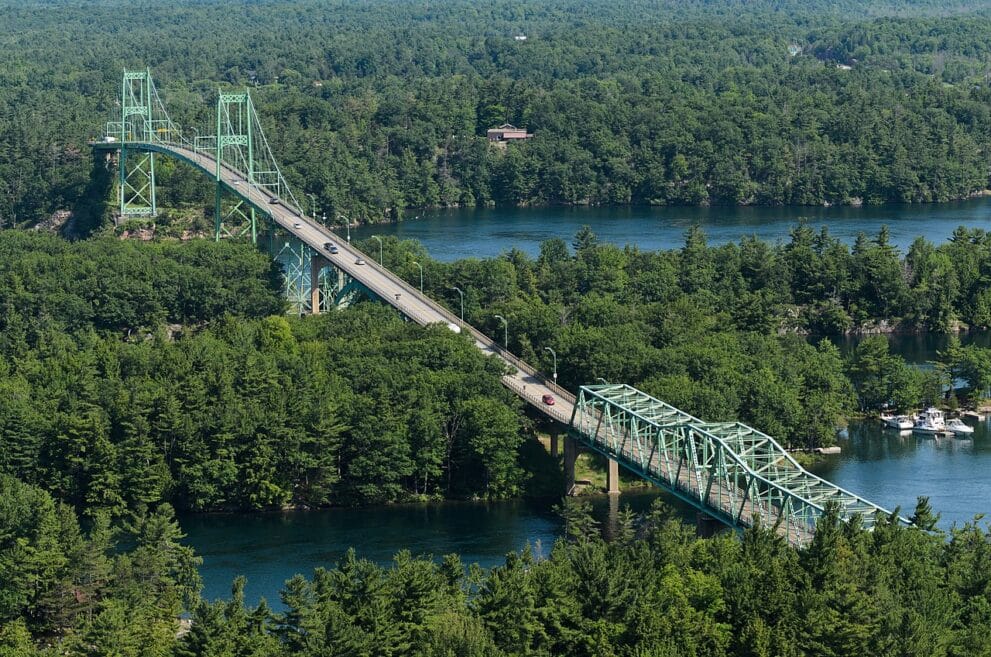
The history of bridges in Canada is a reflection of the nation’s growth, technological progress, and geographical challenges. From indigenous peoples’ early methods of crossing waterways to the sophisticated structures of today, Canada’s bridge history is marked by innovation, expansion, and connectivity.
Indigenous communities initially used natural materials like logs and stones to create simple crossings, adapting to their surroundings. European settlers brought advanced bridge-building techniques, constructing arch, truss, and suspension bridges to facilitate trade and transportation. One of the earliest notable bridges was the Chaudière Bridge built in 1828, connecting Ottawa and Hull.
As the nation expanded, so did its need for improved infrastructure. The Victoria Bridge, inaugurated in 1860, was a pioneering feat, showcasing the combination of rail and road transport. The construction of the Canadian Pacific Railway spurred the creation of numerous railway bridges across vast landscapes.
The early 20th century saw advancements in bridge engineering. The Quebec Bridge, despite tragic failures during construction, demonstrated a commitment to innovation. The Lions Gate Bridge and the Angus L. Macdonald Bridge added to the architectural diversity.
Modern times brought the Confederation Bridge, an engineering marvel connecting PEI to the mainland, and the Samuel De Champlain Bridge, symbolizing Montreal’s progress. Sustainable designs and technologies have become paramount, aligning with Canada’s environmental concerns.
Throughout history, bridges have united communities, facilitated economic growth, and showcased engineering ingenuity. From wooden crossings to steel giants, bridges in Canada tell a story of progress, resilience, and the nation’s journey toward connectivity.
Thousand Islands Bridge, the longest bridge in Canada
The total length of the Thousand Islands Bridge system is approximately 13.679 kilometers (8.5 miles), including its various spans and approaches. It’s a significant international bridge connecting the United States and Canada over the St. Lawrence River and the Thousand Islands region.
The Thousand Islands Bridge is an international bridge system that connects the United States and Canada. It spans the St. Lawrence River and the Thousand Islands region, which is a picturesque area known for its numerous small islands and stunning natural scenery. The bridge system consists of several bridges and islands, facilitating transportation and tourism between the two countries.
The bridge connects Wellesley Island in the United States to Hill Island in Canada. From Hill Island, the bridge extends to the Canadian mainland near the town of Ivy Lea, Ontario. The Thousand Islands Bridge is a vital link for both travelers and commerce between the two nations.
One of the notable features of the bridge is the unique customs and immigration arrangement. There is a shared border inspection station located on Hill Island, where both Canadian and American officials collaborate to process travelers entering or leaving either country. This arrangement streamlines the process for travelers crossing the international border via the bridge.
The Thousand Islands region is a popular destination for tourism, and the bridge provides convenient access for visitors to explore the natural beauty of the islands, as well as engage in recreational activities like boating, fishing, and sightseeing.
It’s worth noting that the Thousand Islands Bridge is part of the larger Thousand Islands region, which is known for its stunning landscapes, historic sites, and the charm of the countless islands dotting the St. Lawrence River.
Confederation Bridge
The Confederation Bridge is approximately 12.9 kilometers (8 miles) long. It’s a significant engineering achievement that spans the Northumberland Strait, connecting Prince Edward Island to the mainland province of New Brunswick in Canada.
The Confederation Bridge is a remarkable engineering feat connecting Prince Edward Island (PEI) in Canada to the mainland province of New Brunswick. Spanning the Northumberland Strait, it’s a vital link for transportation between PEI and the rest of the country.
This bridge is an essential part of Canada’s transportation infrastructure, replacing the need for ferries to reach PEI. The bridge is renowned for its distinctive design, featuring long spans and providing both a roadway and a pathway for pedestrians and cyclists.
The Confederation Bridge is more than just a means of transportation; it’s a symbol of connection and unity, linking an island province to the mainland. The engineering marvel has become an iconic landmark, celebrated for its role in making travel to and from PEI more accessible and efficient.
Orleans Island Bridge
The Orleans Island Bridge, also known as the Pont de l’Île d’Orléans, is a significant bridge located in Quebec, Canada. It spans the St. Lawrence River and connects the mainland with Orleans Island (Île d’Orléans). This bridge is a vital transportation link, providing access to the island, which is known for its historic sites, agricultural activities, and natural beauty.
The bridge is essential for both residents and visitors, offering a convenient route to explore the island’s attractions and communities. It contributes to the local economy by facilitating trade and tourism between the island and the mainland.
In terms of its length, the Orleans Island Bridge stretches approximately 4.4 kilometers from end to end. It’s a key part of the regional infrastructure, showcasing the engineering prowess that enables connectivity across the St. Lawrence River.
Samuel de Champlain Bridge
The Samuel De Champlain Bridge is a significant landmark located in Montreal, Quebec, Canada. This bridge plays a crucial role in the transportation network of the region, spanning the St. Lawrence River and connecting the island of Montreal to the South Shore.
The bridge is named after Samuel de Champlain, a French explorer who played a significant role in the early exploration and colonization of Canada. It replaced the previous Champlain Bridge, which had become outdated and required extensive maintenance.
One of the notable features of the Samuel De Champlain Bridge is its modern design and engineering. The bridge features multiple lanes for vehicular traffic, as well as pedestrian and cyclist pathways. It incorporates advanced technologies to monitor and maintain its structural integrity.
As for its length, the main span of the Samuel De Champlain Bridge is approximately 3.4 kilometers (2.1 miles). This length refers to the portion of the bridge that crosses the St. Lawrence River. The bridge’s modern design and strategic location have contributed to its role as a critical transportation link for the Montreal metropolitan area
Victoria Bridge
The Victoria Bridge is a historic and iconic structure located in Montreal, Quebec, Canada. It holds significant historical and cultural importance as one of the earliest major bridges in Canada. The bridge spans the St. Lawrence River, connecting the island of Montreal to the city of Saint-Lambert on the South Shore.
The Victoria Bridge was inaugurated in 1860 and was a remarkable engineering achievement of its time. It played a crucial role in facilitating transportation and trade between Montreal and other parts of Canada. The bridge was designed to accommodate both railway and vehicular traffic, which was a novel concept during that era.
The bridge’s distinctive lattice truss design is notable, and it has undergone various renovations and improvements over the years to ensure its continued functionality and safety. Although it’s no longer the primary transportation route it once was, the Victoria Bridge remains a historic landmark and a testament to the engineering prowess of the 19th century.
In terms of its length, the Victoria Bridge is approximately 2.7 kilometers (1.7 miles) long. This length encompasses the entire span of the bridge, which crosses the St. Lawrence River. The Victoria Bridge stands as a historical reminder of Montreal’s industrial and transportation heritage.



 Share
Share Tweet
Tweet Share
Share




Comment